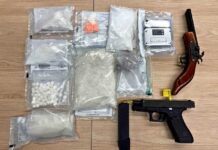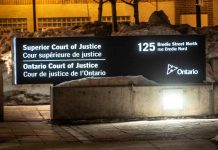THUNDER BAY – On December 4, 2017, Thunder Bay Police Service (TBPS) officers arrested a 41-year-old man for public intoxication. Due to a previous brain injury and his state of intoxication, he was transported to the Thunder Bay Regional Health Science Centre.
The SIU in a media release states, “While waiting to be seen, the man was seated in a wheelchair. When he abruptly stood up, he fell forward and struck his head. The Director of the Special Investigations Unit, Tony Loparco, has determined there are no reasonable grounds to lay criminal charges against a Thunder Bay Police Service officer in relation to this incident.”
Notification of the SIU
At approximately 8:25 p.m. on December 4, 2017, the Thunder Bay Police Service (TBPS) notified the SIUof the custody injury to the Complainant.
The TBPS advised that the Subject Officer (SO) and Witness Officer (WO) #1 responded to a report of an intoxicated person at City Hall in the City of Thunder Bay. The Complainant was arrested for being intoxicated in a public place. While en route to the police station, the police officers were advised that the Complainant was a missing person from a residence for brain injury patients. The police officers were then redirected to the hospital due to the Complainant’s intoxicated state.
Due to congestion at the hospital, the Complainant was placed in a wheelchair. While waiting in the ambulance bay, the Complainant jumped backwards, striking his head on a glass door and then the cement floor. The Complainant was seen by medical staff and had a CT scan and a small brain bleed was observed. The Complainant was admitted to the hospital for observation.
The Complainant is 41-years-old and is a resident of a long-term care facility in the City of Thunder Bay, as a result of a previous brain injury and substance abuse issues.
On December 4, 2017, the SO and WO #1 responded to a call to attend Thunder Bay City Hall where the Complainant had fallen on the sidewalk and could not get up. The Complainant was found to be highly intoxicated and was in possession of a bottle which contained some red wine.
The Complainant was arrested for public intoxication. He was taken to the hospital as a precaution because of his previous brain injury and his current state of intoxication. He was not handcuffed.
While waiting to be triaged, the Complainant was seated in a wheelchair and moved to the ambulance bay because of overcrowding in the off-load delay area. The off-load delay area is a room situated between the Emergency Unit (EU) and the ambulance bay, where paramedics and their patients wait to be triaged. The Complainant abruptly stood up from the wheelchair and fell forward, striking his head on a glass partition separating the garage from the off-load delay area. He gave no indication that he was injured and was helped back into the wheelchair.
There was no closed circuit television (CCTV) camera in the garage area.
On December 4, 2017, the Complainant was observed at the City Hall in the City of Thunder Bay; he was extremely intoxicated and he fell onto the ground on at least one occasion. On the last occasion, the Complainant was unable to get up.
The Complainant, in his interview, rated himself at a ten, on a scale of one to ten for intoxication, with one being stone cold sober and ten being falling down drunk.
CW #6, who was in her office in City Hall, observed the Complainant walking across Donald Street East in the direction of City Hall. She observed the Complainant to be staggering as he walked and she believed him to be in distress. As he walked toward the walkway to City Hall, she observed the Complainant near a curb bordering a garden attempting to sit on the curb. As the Complainant reached for the curb, Civilian Witness (CW) #6 saw him fall forward and she believed that he may have struck his head on the curb as he fell. CW #6 then went down to see the Complainant, but she did not note any obvious injuries. CW #6, however, noted that the Complainant was unable to get up.
CW #5, a security officer at the City Hall, also went to assist the Complainant after he had fallen; the Complainant told him in no uncertain terms that he did not wish his assistance. CW #5 then called 911 and asked that the police attend.
As a result of the 911 call, the Subject Officer (SO) and Witness Officer (WO) #1 were dispatched to deal with the Complainant. The SO arrived first and can be seen on the closed Circuit television (CCTV) footage from City Hall assisting the Complainant to get into a seated position. The SO then requested that CW #5 stay with the Complainant in order that he could bring his police vehicle closer to the Complainant’s location, which he then did. When the SO returned, he assisted the Complainant into his police cruiser.
CW #6 observed the SO help the Complainant up. CW #6 did not observe any type of struggle and did not see the SO do anything which might have injured the Complainant.
CW #5 observed the SO to be very calm when dealing with the Complainant, and not in any way aggressive toward him; at no time did CW #5 observe the SO use any force with the Complainant.
CW #5 indicated that he had dealings with the Complainant in the past, when the Complainant was also intoxicated and had fallen in front of City Hall. He was also aware of a second incident wherein the Complainant had fallen off of a Thunder Bay Transit bus.
WO #1 arrived at City Hall only after the Complainant was already seated in the rear of the SO’s police cruiser. The SO advised WO #1 that he had arrested the Complainant for being intoxicated in a public place, contrary to s. 31 (4) of the Liquor Licence Act, for his own safety.
The SO then began to transport the Complainant to the police station, with WO #1 following, when they were advised that the Complainant had been reported missing from a long term care facility for persons with brain injuries, and they were directed to re-route to the hospital in order to have the Complainant assessed.
Upon arrival at the hospital, the SO and WO #1 assisted the Complainant out of the police cruiser and walked him the 20 feet or so to the ambulance garage bay, with each officer holding onto the Complainant, one on either side of him. Once they arrived in the Emergency Unit, the triage area was full to over flowing and the Complainant was being disruptive, as a result of which he was removed to the ambulance overflow area where the officers had the Complainant sit in a wheelchair.
CW #4, a paramedic who was present at the time, observed WO #1 and the SO help the Complainant into the wheelchair without the use of force. CW #4 described the Complainant as being aggressive and appearing not to want to sit in the wheelchair. Both the SO and WO #1 remained with the Complainant. CW#4 then observed the Complainant to stand up and fall forward, striking his head on the glass to the left of the glass sliding doors that lead into the off-load delay area. CW #4 observed that the Complainant may have fallen as a result of tripping over the wheelchair’s foot rests. WO #1 and the SO, along with CW #4 and another paramedic, then assisted the Complainant back into the chair.
WO #1 indicated that while they were waiting in the garage area, the Complainant suddenly stood up from the wheelchair, twisted to the right, and fell against the glass on the left side of the automatic doors leading into the hospital. WO #1 observed the Complainant’s head to hit the glass near the bottom of the window, following which the Complainant fell onto the floor, landing on his back.
There were numerous paramedics in the garage at the time of the Complainant’s fall, all of whom indicated that they observed no injuries to the Complainant as a result of the fall. Further, they observed that at no time did the Complainant lose consciousness, and his behaviour did not change after the fall. The Complainant was eventually transferred to a stretcher and seen by a doctor.
The Complainant was then sent for a CT scan, which revealed that he had sustained a small (4 mm) acute subdural hemorrhage on the left side of his head. While the injury was determined to be new, the doctor could not say exactly when or by what means the Complainant had sustained the injury. The injury was expected to resolve itself between 24 hours and seven days.
The Complainant, in his statement to SIU investigators, stated that he recalled having fallen backwards onto a sidewalk outside of a casino and striking the rear of his head, following which he lost consciousness. The Complainant recalled two police officers and being taken to the hospital, but he believed that he was taken by ambulance. The Complainant had no recall whatsoever of his interaction with police once at the hospital, or of being seated in a wheelchair, and did not remember falling at the hospital. The Complainant did indicate however that the police did not cause his injury.
The only criminal charge open for consideration on these facts would be one of criminal negligence causing bodily harm contrary to s.221 of the Criminal Code. There is no dispute that the injury sustained by the Complainant was not directly attributable to the actions of the SO or WO #1, the only question being whether or not either, or both, police officers failed in their duty toward the Complainant while he was in their custody. Specifically, the question to be posed is whether the SO or WO #1 omitted to do anything that it was their duty to do and, in failing to do so, showed a wanton or reckless disregard for the life or safety of the Complainant (s.219 of the Criminal Code: definition of criminal negligence).
There are numerous decisions of the higher courts defining the requirements to prove an offence of criminal negligence; while most relate to offences involving driving, the courts have made it clear that the same principles apply to other behaviour as well. In order to find reasonable grounds to believe that the SOand/or WO #1 committed the offence of criminal negligence causing bodily harm, one must first have reasonable grounds to believe that they had a duty toward the Complainant which they omitted to carry out, and that omission, pursuant to the decision of the Supreme Court of Canada in R. v J.F. (2008), 3 S.C.R. 215, represented ‘a marked and substantial departure from the conduct of a reasonably prudent person in circumstances’ where the officers ‘either recognized and ran an obvious and serious risk to the life’ of the Complainant ‘or, alternatively, gave no thought to that risk’. The courts have also made clear that the risk of bodily harm to the Complainant must have been foreseeable to the police officers (R. v Shilon(2006), 240 C.C.C. (3d) 401 Ont. C.A.)
Furthermore, criminal negligence, in and of itself, is not a criminal offence. Rather, the conduct must cause death (section 220) or bodily harm to another (section 221) in order to constitute criminal conduct.
On these facts, which are not in dispute, it is clear that neither the SO nor WO #1 were directly responsible for the injury sustained by the Complainant. On this record, it is frankly unclear exactly when the Complainant sustained his injury, with the possibilities including when he fell on the street outside of City Hall, or when/if he fell outside of the casino, or when he fell while waiting to be seen at hospital, or, alternatively, whether the Complainant, who had a history of falling when he was intoxicated, could have fallen at any time prior to his involvement with police.
On this record, the evidence is incapable of satisfying me that the injury sustained by the Complainant was sustained as a result of his fall at the hospital as opposed to any other time while the Complainant was out and intoxicated. In the absence, then, of some connection between the injury sustained by the Complainant and the actions of the police, the necessary element of ‘causing bodily harm’ cannot be made out, as the evidence cannot establish a causal connection between the actions of police and the injury sustained by the Complainant in the absence of some conclusive evidence of exactly when or how the Complainant sustained his injury.
Having said that, however, even if the evidence did conclusively establish that the Complainant sustained his injury when he fell at the hospital, I could not find that any of the other elements of the offence of criminal negligence causing bodily harm are made out on these facts.
While it is clear that while the Complainant was in the custody of police, they had a duty to see to his care and safety, I cannot find in this circumstance that they failed to carry out that duty. On all of the evidence, the SO was both calm and helpful when he attended and assisted the Complainant when he was unable to get up on his own outside of City Hall. Thereafter, the SO assisted the Complainant into his police vehicle and transported him, out of an abundance of caution, to the hospital. Once at the hospital, the Complainant was again physically assisted out of the cruiser and to the hospital, and then placed in a wheelchair. While unfortunately the triage area was full to overflowing, causing both paramedics, with their patients, and the police, with the Complainant, to have to wait in the garage area, the police officers remained with the Complainant at all times, and saw to his needs as they arose, including immediately assisting him when he fell.
On this evidence, I cannot find that the actions of either police officer amounted to an omission to carry out their duties, nor did they amount to ‘a marked and substantial departure from the conduct of a reasonably prudent person in the circumstances’. Furthermore, I cannot find that the actions of the Complainant, in suddenly getting up from his wheelchair and then immediately losing his balance and falling, would have in any way been foreseeable to the SO or WO #1, and there is no evidence that they ‘either recognized and ran an obvious and serious risk to the life of the Complainant or, alternatively, that they gave no thought to that risk’. Rather than reasonable grounds to believe that the SO of WO #1 showed a wanton and reckless disregard for the life or safety of the Complainant, it appears that they were in fact actively seeking to assist him. Furthermore, once the Complainant fell, both police officers immediately went to his aid.
In all of these circumstances, I cannot find reasonable grounds to believe that the actions of either of the SO or WO #1 satisfy any of the elements required in order to pursue a charge under s.221 of the Criminal Code in that they neither omitted to carry out any duty to act, nor did their actions amount to a marked and substantial departure from the conduct of a reasonably prudent person in their circumstances. Finally, they did not show a wanton or reckless disregard for the life or safety of the Complainant, and his subsequent injury, if it was indeed sustained when he fell at the hospital, which is far from certain, was totally unforeseeable in the circumstances. On all of the evidence, it appears that there is no causal connection between the actions of the police officers and the injury to the Complainant. In sum, I can find no basis for the laying of criminal charges and none shall issue.
Date: November 7, 2018
Original signed by
Tony Loparco
Director
Special Investigations Unit
The SIU is an arm’s length agency that investigates reports involving police where there has been death, serious injury or allegations of sexual assault. Under the Police Services Act, the Director of the SIU must
- consider whether an officer has committed a criminal offence in connection with the incident under investigation
- depending on the evidence, lay a criminal charge against the officer if appropriate or close the file without any charges being laid
- report the results of any investigations to the Attorney General.







